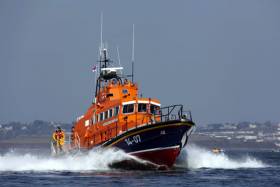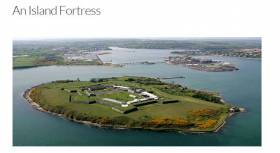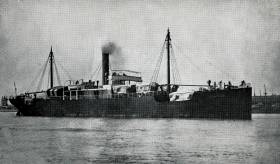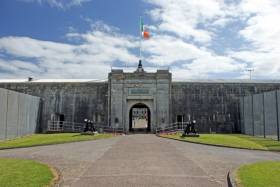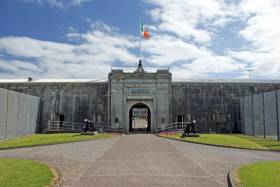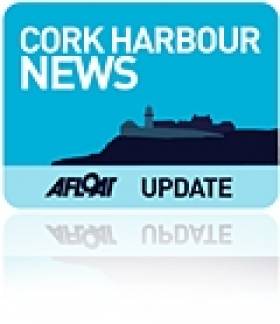Displaying items by tag: Spike Island
Crosshaven RNLI Medevac Elderly Man from Spike Island in Cork Harbour
Shortly before noon today (1st September), Valentia Coast Guard requested a launch to attend an elderly man who had collapsed on Spike Island.
The crew of Aidan O’Connor, Norman Jackson, Derek Moynan and Claire Morgan made best speed in calm conditions to Spike Island and located the casualty towards the top of the Island.
Casualty Care was administered and the casualty brought to the Island pontoon and onto the lifeboat before being brought to Crosshaven lifeboat station and handed into the care of NAS Paramedics and the lifeboat Doctor, Dr John Murphy. The casualty was removed to Cork University Hospital.
Kieran Coniry of the Port of Cork, readied a RIB with the intention of transferring the Paramedics to Spike Island, but was stood down when it was realised the lifeboat was ready to leave the Island.
Launch and recovery crew: Ml McCann, Warren Forbes, Hugh Mockler, Susanne Deane, Jonny Bermingham and Gary Heslin. DLA was Darryl Hughes.
Although there was a small enough turnout, the Irish Examiner sponsored Round Spike Island Race was sailed in beautiful sunshine in Cork Harbour.
Eight keelboats and six dinghies competed for the annual Royal Cork Yacht Club hosted event.
Scroll down for photo gallery below
The cruisers went off first being given a course to No. 3 buoy at the mouth of the harbour and then round Spike and a finish in the river at Currabinny Pier near the Royal Cork clubhouse at Crosshaven.
The dinghies had a reach mark laid off Spike and then onwards to round the island.
 Alex Barry, at the helm of the winning National 18 dinghy Photo: Bob Bateman
Alex Barry, at the helm of the winning National 18 dinghy Photo: Bob Bateman
Alex Barry, at the helm of a National 18, won the dinghy prize against a mixed fleet including an Oppie, a Topper, a Wayfarer and three visiting 505s.
 The Young Family's North Star was the Cruiser winner of the Round Spike Island Race Photo: Bob Bateman
The Young Family's North Star was the Cruiser winner of the Round Spike Island Race Photo: Bob Bateman
The Young Family's North Star won the keelboat prize.
Bob Bateman's RCYC Round Spike Island Photo Gallery
This year's Cork Harbour Round Spike Island Race will take place on Sunday at the Royal Cork Yacht Club in Crosshaven in both dinghies and keelboats for the 'Irish Examiner 'trophy.
Boats of all types and sizes regularly compete in the annual race.
High Tide at Cobh is 12:28 hours, giving boats 3.5 metres to get around, so First Gun for the race will be at 11:55 hours in the vicinity of Cage buoy.
 Even small Optimist dinghies compete in the Round Spike Island Race Photo: Bob Bateman
Even small Optimist dinghies compete in the Round Spike Island Race Photo: Bob Bateman
Courtmacsherry RNLI was among the search and rescue agencies who responded yesterday morning (Thursday 8 August) to reports that a man had taken ill during a diving expedition to the wreck of the Lusitania.
As reported by The Irish Times, it is suspected that the diver, one of a group of eight, developed the bends as he returned to the surface from the wreck site some 18km off the Old Head of Kinsale.
The Naval Service vessel LÉ George Bernard Shaw diverted from patrol in the area and sent a team to bring the casualty on board, from where he was airlifted to hospital.
Later the casualty was transferred from Cork University Hospital to University Hospital Galway, which has a decompression unit.
As the emergency operation wound down, Courtmacsherry RNLI’s all-weather Trent class lifeboat Frederick Stormy Cockburn received another Mayday call, to a 30ft yacht in difficulty off the Seven Heads coast.
The lifeboat was at the scene within 20 minutes and proceeded to tow the stricken vessel back to the safe surrounds of Courtmacsherry Pier.
Commenting on the morning’s callouts, Courtmacsherry lifeboat operations manager Brian O'Dwyer praised all the crew for their professionalism and fast response.
Elsewhere, shortly after 1pm, Crosshaven lifeboat volunteers were called to a medical evaluation from Spike Island in Cork Harbour.
According to Crosshaven RNLI, crew member Aoife Dinan performed casualty care until paramedics arrived, having been brought to the Island by the Port of Cork RIB.
The Irish Community Air Ambulance also landed on the island along with Crosshaven Coast Guard.
“Very sadly, the male casualty, who was a foreign visitor, was declared deceased,” said press officer Jon Mathers. “Our sympathies are with the family of the deceased man; may he rest in peace.”
The number of visitors to Spike Island has risen to 25% so far in 2019, with the operation of a new, larger-capacity ferry just one of a number of developments at the Cork Harbour destination.
The new ferry, reports EchoLive.ie, is the 126-seater Spike Island which has been operating since Friday, April 19.
As a result, the busiest day for Easter 2019 was up 50% on Easter 2018, according to a report from the Tourism Directorate of Cork County Council.
“The Spike Island … is more comfortable with a larger capacity that the Bryan J, which was used previously,” the report said.
“The new contract with Doyle Shipping Group provides for the use of both vessels, which will significantly increase capacity to transfer tourists between Cobh and the Island.”
More on the story can be read here.
Spike Island Awarded Europe's Leading Tourist Attraction
#SpikeIsland - In Cork Harbour the visitor centre on Spike Island run by Cork County Council has been named Europe's leading tourist attraction at the 2017 World Travel Awards.
RTE news writes that Fortress Spike Island saw off competition from the Eiffel Tower, Buckingham Palace and Rome's Colosseum to win the award.
The 104-acre Spike Island was a monastic settlement in the seventh century, a British artillery fortification from the 18th century, and a prison from where thousands of convicts were transported to Australia in the 19th century.
It remained under British control, even after the Anglo-Irish Treaty of 1921, and was handed over to the Irish State in 1938.
It operated as a prison again from 1985 until the last of the prisoners left in 2004.
To read more on this tourist attraction award, click here.
S.S. Aud: New Exhibition Opens on Spike Island
#Exhibition - A new permanent display commemorating the gun-running ship Aud opened recently on Spike Island, Cork Harbour.
The exhibition writes East Cork Journal honours the men and crew of the German vessel which was scuttled in the harbour in 1916.
The German crew were attempting to deliver weapons as part of the preparations for the Easter Rising, when the ship was trapped by a blockade of British ships.
9 April: SS Libau masquerading as the SS Aud under the command of Karl Spindler set sail for Tralee bay. Under Spindler was a crew of 22 men. The vessel was laden with an estimated 20,000 riffles, 1 million rounds of ammunition, 10 machine guns and explosives.
While the vessel was at sea the meeting date had changed to the 23 April.
20 April: The Libau / Aud arrived in Tralee bay unaware of the change of date. The crew were to Rendezvous with Roger Casement who was landed close by, by a German u-boat.
The ship was spotted by a blockade of British ships and escorted towards Cork Harbour.
22 April: At exactly 6:30pm the crew scuttled the ship outside Cork Harbour.
If the meeting had gone as originally planned and the Irish kept their side of the agreement history may have been rewritten.
The exhibition is supported by the Department of Arts, Heritage, Regional, Rural and Gealtacht affairs.
Research Reveals Spike Island Prison ‘Death Trap’
#SpikeIsland - The burial of a graveyard on Spike Island in the mid-19th century covered up the “death trap” conditions at its Victorian-era prison.
That’s according to new research on the site in Cork Harbour, as The Irish Times reports, that investigates the extraordinary mortality rate at what was once the largest prison in the United Kingdom, but has now been restored as a tourist attraction.
Though blamed on famine conditions in Ireland at large, UCC researcher Dr Barra O’Donnabhain says poor sanitation and malnutrition among the more than 2,300 prison population were more directly to blame.
The result was some 80% of all 1,200 convict deaths recorded for the 36 years of the prison’s existence occurring within a single five-year period, between 1850 and 1854.
“The burial of the graveyard was ostensibly done as part of the completion of the fortifications on the island, it also conveniently hid the evidence,” says Dr O’Donnabhain.
The Irish Times has much more on the story HERE.
Spike Island Set To Open For Summer Visitors
#CorkHarbour - Spike Island's new interpretive centre is scheduled to welcome its first visitors this summer, according to the Evening Echo.
As previously reported on Afloat.ie, Block B of the old prison building was earmarked for refurbishment as a visitor centre for what's hoped to be a major tourist attraction in Cork Harbour.
The first phase of these works, comprising a new pontoon and pier upgrades as well as a previously envisaged exhibition of military memorabilia, is now expected to be ready and open to the public by June.
A passenger ferry service from Cobh to Spike Island will also be running in time for the summer season.
The Evening Echo has more on the story HERE.
Spike Island Interpretive Centre Could Be Ready By Next Summer
#CorkHarbour - Five years after Spike Island was first opened as a tourist attraction, plans are in the making for a new interpretive centre on the site that could be ready by next summer.
As the Irish Examiner reports, the €2.5 million Fáilte Ireland-funded project for the former prison island in Cork Harbour could see ground broken as soon as September ahead of ribbon cutting in time for the 2016 summer tourism season.
According to county engineer David Keane, Block B of the old prison building will be refurbished for the visitor centre, which will house an exhibition on the history of the island as well as military memorabilia.
It's hoped that the plans will attract up to 300,000 visitors to Cork Harbour annually, and create some 190 jobs.
The Irish Examiner has much more on the story HERE.


























